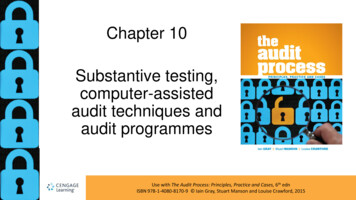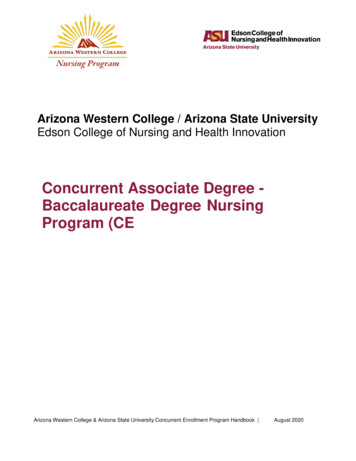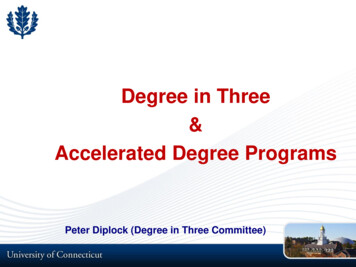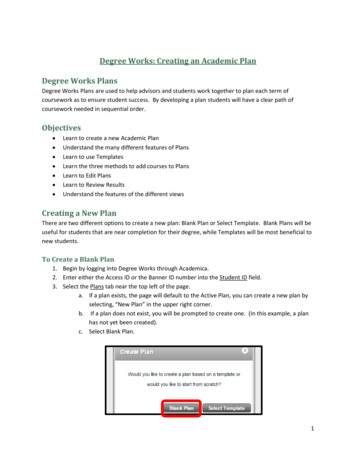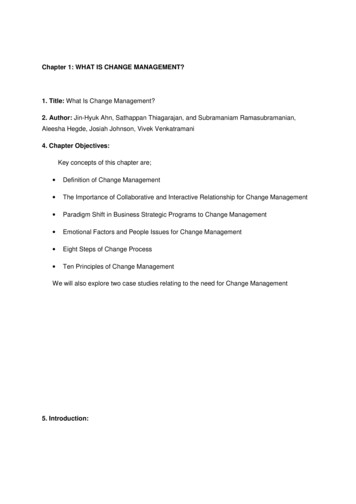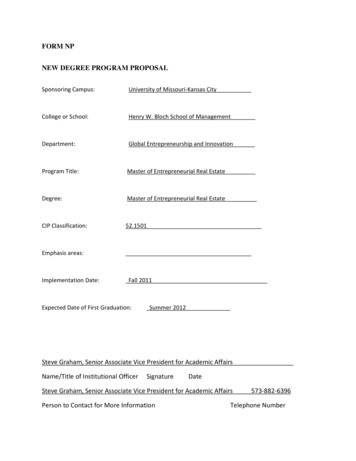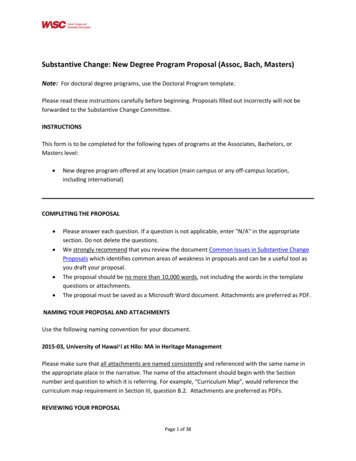
Transcription
Substantive Change: New Degree Program Proposal (Assoc, Bach, Masters)Note: For doctoral degree programs, use the Doctoral Program template.Please read these instructions carefully before beginning. Proposals filled out incorrectly will not beforwarded to the Substantive Change Committee.INSTRUCTIONSThis form is to be completed for the following types of programs at the Associates, Bachelors, orMasters level: New degree program offered at any location (main campus or any off-campus location,including international)COMPLETING THE PROPOSAL Please answer each question. If a question is not applicable, enter "N/A" in the appropriatesection. Do not delete the questions.We strongly recommend that you review the document Common Issues in Substantive ChangeProposals which identifies common areas of weakness in proposals and can be a useful tool asyou draft your proposal.The proposal should be no more than 10,000 words, not including the words in the templatequestions or attachments.The proposal must be saved as a Microsoft Word document. Attachments are preferred as PDF.NAMING YOUR PROPOSAL AND ATTACHMENTSUse the following naming convention for your document.2015-03, University of Hawaiʻi at Hilo: MA in Heritage ManagementPlease make sure that all attachments are named consistently and referenced with the same name inthe appropriate place in the narrative. The name of the attachment should begin with the Sectionnumber and question to which it is referring. For example, “Curriculum Map”, would reference thecurriculum map requirement in Section III, question B.2. Attachments are preferred as PDFs.REVIEWING YOUR PROPOSALPage 1 of 38
Before submitting your proposal, the Accreditation Liaison Officer (ALO) should conduct a review of theproposal noting the following: The proposal uses the appropriate form and is named correctly.All questions in the proposal are answered completely and directly, or marked as “N/A”.The narrative is complete, clear, and understandable to someone outside of the department orinstitution.All attachments open.All attachments are referenced in the narrative in the appropriate section.All hyperlinks function appropriately.There are no font or formatting inconsistencies that might distract the readers.SUBMITTING YOUR PROPOSAL Refer to the “READ ME FIRST Sub Change Proposal Submission Instructions” document in theBox.com folder for this proposal.Request that your institution's Accreditation Liaison Officer notify Marcy Ramsey(mramsey@wascsenior.org) once the proposal is complete and has been uploaded to Box.com.RESOURCESFor more information on substantive change policy and procedures, please refer to: The Substantive Change Manual.Information on the Degree Level Approval Policy.Samples of substantive change proposals may be found at: http://samples.wascsenior.org.The rubric used by the Committee for scoring can be in the Box.com folder for your proposal.Additional resources and documents may be found on the Substantive Change page or inthe Document Library on the WSCUC website.NEXT STEPSOnce the proposal is uploaded into Box.com, WSCUC staff will conduct a preliminary review of theproposal to determine if additional information is needed before forwarding the proposal to theSubstantive Change review panel. It is very unusual that a proposal is not returned to the institutionwith at least a couple of clarifying questions.Approximately one month prior to the conference call date, the ALO will receive an email notificationrequesting response to any questions. Detailed information about how to revise the proposal will alsoPage 2 of 38
be provided. You will have one week to respond. After the revised proposal is submitted, it will beforwarded to the Substantive Change Committee for their review.Page 3 of 38
Degree or Program Name: 2015-03, Universityof Hawaiʻi at Hilo:MA in Heritage ManagementSection I: Program and Institutional OverviewA. Program Overview1. List the percent of the program being offered:On-campus: 97%Via distance education: 3%Off-campus: 0%Location of new site: N/AInternationally: N/ALocation of new site: N/AIf the program will be delivered in a hybrid/blended format, please briefly explain how the program willbe delivered (example: The program contains a combination of face-to-face courses held on-campus,online courses, and several weekend residencies at an off-campus location).Initially, all classes will be face-to-face in classrooms and labs, with internships (discussed below). By thefourth year of the program, we hope to integrate at least two DL hybrid courses (6 credits out of 36total) that will be offer a live-stream option, but with most students on-campus. That will provide thepotential for some students on other islands to receive instruction from other locales. The figurepresented above is calculated as the total percentage of distance education credits if 2 students out of 9in the 3rd admitted cohort opt to complete their second-year credits through live stream.2. What is the anticipated start date of classes?August 24, 20153. If 50% or more of the program will not be in English, identify the language of instruction.See WSCUC’s Policy on Instruction in Languages Other than English.N/APage 4 of 38
B. Institutional Context (CFRs 1.1, 1.2, 2.2, 2.2a, 2.2b, 4.6, 4.7)1. Provide a brief description of the institution including the broader institutional context in which thenew program or site will exist. Connect the anticipated substantive change with the mission, purpose,and strategic plan of the institution.The University of Hawai‘i at Hilo is a comprehensive, public liberal arts institution that originally beganas “Hilo College” in 1947. In 1970, Hilo College was renamed the University of Hawai‘i at Hilo (hereafterreferred to as “UH Hilo”) as it became a baccalaureate granting institution. UH Hilo is situated in a small,rural community on the southernmost island in the Hawaiian chain. The Institution reflects the diversityof its surroundings in that of 2011 full-blooded Native Hawaiians and other indigenous Pacific Islandersmade up 11.9% of the total student population of undergraduates; Asians (including Filipino)19.2%;Mixed Ancestry 29.7% (a category which includes a majority of Native Hawaiians); and Whites 23%.Our Mission Statement includes the following tenets: Access to education: We provide access to higher education while holding high expectations forall students and providing support for their success.Learning from many sources: We offer an engaging atmosphere of learning where knowledge iscreated and shared, values and wisdom are preserved, and individuals can learn from oneanother. Learning occurs not only in the classroom, but in the laboratory, in the field, in thestudio, through performance and presentation, in partnerships with our community, and in oureveryday lives.Connecting instruction with research, service, and professional experiences that empower ourstudents to achieve their academic and career goals.Student-faculty interaction: We recognize the value of dialogue, discussion and debate betweenand among students and their faculty, fostered by quality student-faculty engagement andcollaboration, and out-of-class experiences.Diversity and cultural infusion: We celebrate different people, their backgrounds and history,and the unique cultural mosaic of Hawai‘i that brings the feel of a global community to our localcampus.Stewardship of the natural and cultural environment: We respect the ‘āina/land and appreciatethe many lessons it has to teach. We work in partnership with the community to study, protect,preserve and sustain the unique cultural and natural environment of Hawai‘i Island.Community partnerships and economic impact: We are dedicated to our role as a majoreconomic and knowledge-based resource for the Island, state and region. We work inpartnership with local government and agencies, businesses, non-profit groups, alumni, andother educational institutions to create a positive impact on our students, local community andeconomyThe MA in Heritage Management is a program dedicated to developing a local base of expertise inhistorical site preservation and management in a manner that fits the State’s and Pacific region’s uniquePage 5 of 38
cultures and histories. In partnership with Kamehameha Schools (a Native-Hawaiian serving educationfoundation), and a collaborative agreement with the National Park Service, UH Hilo’s MA in HeritageManagement will be reaching out to a wide range of ethnic populations while striving to uphold the coreessence of Pacific Islander descendant community values—educational, social, and cultural.2. To demonstrate prior experience, list the number, variety and longevity of other programs at theproposed degree level and/or modality, and include a brief summary or profile of one of theseprograms.UH Hilo was first accredited by WASC in 1976. At that time, UH Hilo was operationally integrated withHawai‘i Community College (henceforth referred to as HAWCC). HAWCC and UH Hilo formally separatedin Fall of 1990 (though we still share some of the same facilities). At that time, enrollment was pegged at2,874 with the institution offering baccalaureate degrees in 29 disciplines and certificates in another12.Today, we have an enrollment of 4,058 with 36 undergraduate programs (with 25 possible minors), 24Certificate or Licensure Programs, 6 Master’s Degrees, and 4 Doctorates.The list of degrees are as follows:College of Agriculture Forestry, and Natural Resource ManagementBS in Agriculture (1975)Beekeeping Certificate (2014)Forest Resource Management and Conservation Certificate (2010)Plant Tissue Culture Certificate (2002)Tropical Farming Certificate 2014)College of Business and EconomicsBA in Accounting (2007)BA in Business Administration (1975, DL 2012)BA in Economics (1972)Accounting Certificate (2015)Asia Pacific-US Economic Certificate (2015)Business Administration Certificate (2003)Finance Certificate (2015)International Studies Certificate (Tourism) (1999)College of Arts and Sciences: Arts & HumanitiesMA in China-US Relations (2004)BA in Art (1987)BA in Communication (1970, DL in 2012))BA in English (1970)BA in Japanese Studies (1975)BA in Performing Arts (2003)Page 6 of 38
BA in Philosophy (1972)Chinese Studies Certificate (2012)Filipino Studies Certificate (2013)Performing Arts Certificate (1989)Teaching English as a Second Language Certificate (2004)College of Arts and Sciences: Natural SciencesMS in Tropical Conservation Biology and Environmental Science (2004)BS in Astronomy (1994)BA/BS in Biology (1970)BS in Chemistry (1972)BS in Computer Science (1987)BA/BS in Geology (1985)BA in Marine Science (1993)BA in Mathematics (1970)BA in Natural Science (1992)BA in Physics (1972)Computer Application Development Specialization Certificate (2010)Database Management Certificate (2001)Global Engagement Certificate (2014)Marine Option Program Certificate (2010)STEM Research Honors Certificate (2015)College of Arts and Sciences: Social SciencesDNP in Nursing Practice (2012)MA in Counseling Psychology (2004)M.ed. in Education (2000)MA in Teaching (2013, DL 2013)BA in Administration of Justice (2002)BA in Anthropology (1970)BA in Geography (1971)BS in Environmental Science (2008)BA in Environmental Studies (2008)BA in History (1970)BA in Kinesiology and Exercise Science (2004)BS in Nursing (1992, DL in 2012)BA in Political Science (1972)BA in Psychology (1971)BA in Sociology (1971)Education Studies Certificate (2012)Environmental Studies Certificate (1996)International Studies Certificate (International Relations) (1999)Pacific Islands Studies Certificate (1994)Planning Certificate (1989)Women’s Studies Certificate (1992)Page 7 of 38
College of Arts and Sciences: InterdisciplinaryBA in Liberal Studies(1971)College of Hawaiian LanguagePhD in Hawaiian and Indigenous Language and Culture Revitalization (2006)MA in Hawaiian Language and Literature (1998)MA in Indigenous Language and Culture Education (2006, DL in 2007)BA in Hawaiian Studies (1984)BA in Linguistics (1973)Contemporary Indigenous Multilingual Certificate (2013)Hawaiian Culture Certificate (2013)Hawaiian Language Certificate (1999)Ka Huawaiola Indigenous Teacher Education (1999)Multidisciplinary Hawaiian Studies Certificate (2013)College of PharmacyPharmD in Pharmacy (2007)PhD in Pharmaceutical Science (2011)MS in Clinical Psychopharmacology (DL 2011)BA in Pharmacy Studies (2011)Description of the B.A. in Communication:The UH Hilo Department of Communication offers a communication major and minor and courses in theareas of interpersonal, intercultural, organizational, public, and mass communication.The Department of Communication provides a strong foundation in human communication theories andpractices. Our program emphasizes multicultural team and community building in a personalizedlearning environment. The program emphasizes multicultural perspectives, authentic communication,valuing diversity, professional and personal empowerment, and enhanced self-awareness. Studentsdevelop oral, written, group, interpersonal, intercultural, and organizational communication skills thatprepare them for leadership and citizenship in a diverse civil democratic society. (For more informationon the mission and SLOs for this degree, please see http://hilo.hawaii.edu/academics/communication/ )Incepted in 1970, the B.A. in Communication was also approved through WASC substantive change as anonline degree program as it is possible for students to take more than 50% or more of their major via DL.SEE PDF—COMM (ATTACHMENT 1) IN THE FOLDER CALLED “HYPERLINKS”.The website detailing this DL portion of this major can also be found ngBAComm.php .Page 8 of 38
3. If this is the first degree program at this level, provide the rationale for the change in degree level anddescription of what the institution has done to build an appropriate academic culture at that level (i.e.,research expectations, opportunities, and funding for faculty, research opportunities for graduatestudents, appropriate library resources.)WSCUC Reviewer Comment: Please provide the profile of a current MA program including patterns ofenrollment, graduation and retention rates, and evidence of fiscal sustainability.To help reviewers understand the fiscal health of a comparable undergraduate/graduate program, datafrom the Department of Psychology (which houses the B.A. In Psychology and the M.A. in CounselingPsychology) has been provided.SEE “MA PROFILE (PSYCHOLOGY)” IN THE MAIN FOLDERC. Accreditation History Relevant to Substantive Change (CFR 1.8)1. What other degree programs have been reviewed by the Substantive Change Committee in the past12 months and/or planned for review in the next 12 months? Provide a brief summary of issues notedby WSCUC in prior substantive change reviews since the institution’s last comprehensive review and theinstitution’s response to these issues, even if the programs reviewed were at a different degree level oroffered in a different discipline.None2. Provide the institution’s response to issues noted by WSCUC in prior Commission or other Committeeaction letters or visiting team reports that are relevant to the proposed substantive change. Contactyour WSCUC staff liaison if you need more information.In 2011, UH Hilo was found to be out of compliance with WASC Standard 1.9 with regard to DLcomponents in the following programs/degrees which had not applied for substantive change: BA in CommunicationThe AA to BA in PsychologyThe RN to BSN in NursingMA in Clinical PsychologyThe MA in Indigenous Language and Culture EducationUH Hilo has since undergone substantive change review for all of the above. SEE “PDF—ACTION LETTER(ATTACHMENT 2)” IN THE FOLDER CALLED “HYPERLINKS”.The response to Commission’s action letter also can be found ments/ResponsetoWASCletterofMarch282011.pdfPage 9 of 38
3. If the proposed program is within a school accredited by a professional accrediting agency, or isrelated to a program that is accredited by a professional accrediting agency, list the agency, yearaccredited, and attach as PDF a copy of the executive summary to the most recent team evaluationreport and agency action. Also, indicate whether the specialized agency needs to review and approvethe proposed program prior to implementation or when in the program’s schedule that the review willbe scheduled. Provide similar information for licensure purposes.N/ASection II: Program Need and ApprovalA. Program Need (CFRs 1.1, 1.7, 1.8, 2.1, 2.12, 4.1–4.3, 4.6, 4.7)1. Describe the program need/rationale framed by the institution's mission and strategic goals.Relationship to UH Hilo Strategic Plan. The proposed program fits well with virtually all of UH Hilo’sstrategic plan goals, but most strongly relates to Goals 4 and 5.5. Goal 4 is to “cultivate, sustain andreflect a diverse, multicultural university that is rooted in the indigenous history of Hawai‘i,” and Goal 5.5is to “enhance our scholarship and partnerships with the community to responsibly preserve, protect andsustain natural and cultural resources.”The program will contribute to UH’s five 2008-2015 strategic areas: 1) Native Hawaiian EducationalAttainment, by supporting the access and success of Native Hawaiians in a field of profound cultural andspiritual importance to them; 2) Hawai‘i’s Educational Capital, in particular by making graduateeducation available to students living in under-served areas that contain significant archaeological sites;3) Economic contribution, by providing trained professionals in an area of high demand in the State; 4)Globally competitive workforce, by offering training in heritage management to students from areaswhere indigenous artifacts and sites are endangered by development and industrialization, and 5)Resources and stewardship, by leveraging existing University resources and relations among universityunits.2. Describe the methods used to collect evidence (surveys, focus groups, documented inquiries, etc.)that supports the enrollment projections and the conclusion that interest in the program is sufficient tosustain it at expected levels. Evidence should demonstrate interest in this program specific to yourinstitution, as well as broader trends and employment outlook. Please provide a summary of thefindings, not the full study.Page 10 of 38
A recent national study 1 of heritage management professionals has predicted that the number ofarchaeologists with graduate degrees will double to meet the expected demand in the next 25 years. Ofan estimated total of 19,150 archaeological jobs, 85% will be filled with MA level archaeologists. InHawai‘i, there are currently 24 private firms and nine universities permitted to conduct archaeologicalresearch. The five largest firms together employ approximately 150 persons. The remaining 19 firmsemploy ten or fewer persons each. A reasonable estimate would be 250 employees in private consultingalone, not including those employed by universities. Various agencies of the US government (such as theNational Park Service, Department of Defense, Natural Resource Conservation Service, and US Fish andWildlife Service), employ about a hundred specialists in heritage management in the Pacific region. TheState of Hawaiʻi also maintains the State Historic Preservation Division (SHPD) within the Dept. of Landand Natural Resources and currently has about a dozen preservation specialists on board, but they oftenhave employed more (around 30 in the 1990s). Kamehameha Schools, the Office of Hawaiian Affairs,Hawai‘i State Parks, and various counties also employ individuals who specialize in heritagemanagement, which would result in an estimate of at least 400 professionals working in heritagemanagement in the Pacific, of which 85% (340) would benefit from graduate training.Th
Masters level: New degree program offered at any loc ation (main campus or any off-campus location, including international) COMPLETING THE PROPOSAL Please answer each question. If a question is not applicable, enter "N/A"
